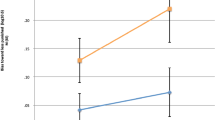Abstract
Twenty-five hyperactive boys and 25 controls matched for age, social class, and race were compared on three performance tasks (coding, tone discrimination, and connecting dots) in two settings (nondistracting and highly distracting). Control Ss performed significantly better than did hyperactives in all conditions, except during tone discrimination and connecting dots in the nondistracting setting. Distraction decreased performance for both groups on the coding task and for hyperactives on the tone discrimination task, but significantly improved performance for controls on the connecting dots task. Distraction, where detrimental, was not significantly more so for hyperactives than for controls. The effect of reward on coding performance was studied in the distracting condition; reward produced the best performance for both groups, but significant differences between groups were not found.
Similar content being viewed by others

References
Browning, R. Effect of irrelevant peripheral visual stimuli on discrimination learning in minimally brain-damaged children.Journal of Consulting Psychology, 1967,31, 371–376.
Clements, S.Minimal brain dysfunction in children: Terminology and identification. U.S. Public Health Service, Pub. No. 1415. Washington, D.C.: U.S. Government Printing Office, 1966.
Conners, C. The syndrome of minimal brain dysfunction: Psychological aspects.Pediatric Clinics of North America. 1967,14, 749–760.
Cruickshank, W., Bentzen, F., Ratzeburg, R., & Tannhauser, M.A teaching method for brain-injured and hyperactive children. Syracuse, N.Y.: Syracuse University Press, 1961.
Doubros, S., & Daniels, G. An experimental approach to the reduction of overactive behavior.Behavior Research and Therapy, 1966,4, 251–258.
Edwards, A.Experimental design in psychological research. New York: Rinehart &Co., 1950.
Eisenberg, L. The management of the hyperkinetic child.Developmental Medicine and Child Neurology, 1966,8, 593–598.
Koppitz, E.The Bender-Gestalt Test for young children. New York: Grune & Stratton, 1964.
Martin, G., & Powers, R. Attention span: An operant conditioning analysis.Exceptional Children, 1967,33, 565–570.
Paine, R. Syndromes of “minimal cerebral damage.”Pediatric Clinics of North America, 1968,15, 779–801.
Patterson, G. An application of conditioning techniques to the control of a hyperactive child. In L. Ullman, & L. Krasner (Eds.),Case studies in behavior modification. New York: Holt, Rinehart, & Winston, 1965.
Patterson, G., Jones, R., Whittier, J., & Wright, M. A behavior modification technique for the hyperactive child.Behavior Research and Therapy, 1965,2, 217–226.
Stevens, D., Boydstun, J., Dykman, R., Peters, J., & Sinton, D. Presumed minimal brain dysfunction in children: Relationship to performance on selected behavioral tests.Archives of General Psychiatry, 1967,16, 281–285.
Strauss, A., & Lehtinen, L.Psychopathology and education of the brain injured child. New York: Grune & Stratton, 1947.
Thompson, L. Learning disabilities: An overview.American Journal of Psychiatry, 1973,130, 393–399.
Wechsler, D.Wechsler Intelligence Scale for Children. New York: Psychological Corporation, 1949.
Werry, J., & Sprague, R. Hyperactivity. In Costello, C. (Ed.),Symptoms of psychopathology: A handbook. New York: Wiley, 1970.
Author information
Authors and Affiliations
Additional information
This research was supported in part by U.S. Public Health Service Training Grant (in Biological Sciences) No. MH07081.
The participation of the following people in helping to design this research study and collect data is hereby acknowledged: David Bremer, Ted Goltz, Ruth Rosenthal, and Michael Stern.
Rights and permissions
About this article
Cite this article
Worland, J., North-Jones, M. & Stern, J.A. Performance and activity of hyperactive and normal boys as a function of distraction and reward. J Abnorm Child Psychol 1, 363–377 (1973). https://doi.org/10.1007/BF00917635
Issue Date:
DOI: https://doi.org/10.1007/BF00917635



